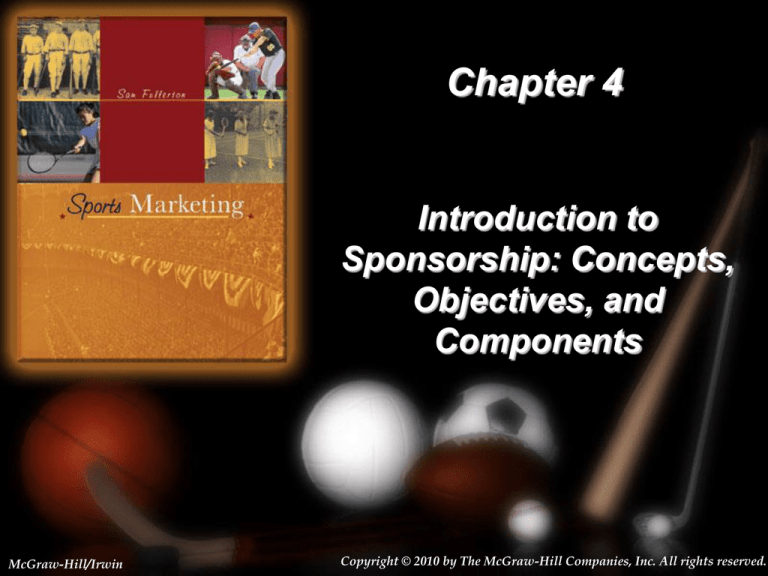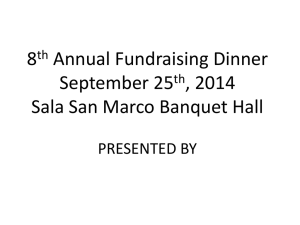
Chapter 4
Introduction to
Sponsorship: Concepts,
Objectives, and
Components
McGraw-Hill/Irwin
Copyright © 2010 by The McGraw-Hill Companies, Inc. All rights reserved.
4-1
Sponsorship’s Role
• Another Promotional Tool for Marketers
• Sponsorship Should Have a Synergistic Effect
on a Marketer’s Promotional Efforts
• Sponsorship Fits within the Promotional Mix
• Integrated Marketing Communications (IMC)
4-2
Integrated Marketing Communications
(IMC) Plan
•
•
•
•
•
Advertising
Personal Selling
Sales Promotion
Public Relations / Publicity
Sponsorship
• Key Is How They All Work in Harmony
• Sponsorship Is NOT Advertising
4-3
Evolution of Sponsorship Motives
• Early Sponsorships Were Ego-Driven
– CEO likes golf; company sponsors golf event
• Focus Shifted to Philanthropic Motives
– Sponsorship was a way to contribute to a cause
• Most Sponsorships Today Focus on ROI
– Sponsorship as an investment, not an expense
4-4
Advertising’s Advantages
• Persuasive Message
– Words and Images Used to Convey Ideas
• Standardization
– Everyone Receives an Identical Message
• Guaranteed Size of Audience Reached
– Circulation; TV Ratings; Radio Ratings
4-5
Advertising’s Advantages (Cont’d)
• Evaluation of Effectiveness
– Measures such as CPM Can Be Applied
– Measure the Impact on Sales
– Concept Testing Prior to Using Advertisement
• Turnkey
– May Be a Stand-Alone Tactic That Is Not
Supported by Other Elements of the IMC
4-6
Sponsorship
• A Relationship between a Marketer and a
Property in Which the Marketer Pays a
Cash or In-Kind Fee in Return for Access
to the Exploitable Commercial Potential
Associated with the Property
• Many Types of Properties that Represent
Sponsorship Opportunities for a Marketer
4-7
Sponsorship’s Advantages
•
•
•
•
•
•
Credibility
Image
Prestige
Internal Morale
Sales Opportunities
Access to Live Audience
4-8
Sponsorship Categories
• Sports
• Entertainment, Tours & Attractions
• Cause-Related Marketing
• Festival, Fairs & Annual Events
• The Arts
• Associations and Membership Organizations
4-9
Sponsorship Spending by Category
(2008)
•
•
•
•
•
•
Sports (69%)
Entertainment, Tours & Attractions (10%)
Cause-Related Marketing (9%)
The Arts (5%)
Festival, Fairs & Annual Events (4.5%)
Associations and Membership Orgs (3%)
* Rounding creates small statistical error (IEG)
4-10
Worldwide Sponsorship Spending
• Drop in Table 4.2 Here
4-11
Key Sponsorship Concepts
• Participants
– Sponsor – Party Seeking Association (Visa)
– Sponsee – Property Owner (e.g. FIFA)
• Linkages
– Self-Evident – adidas products used in event
– Strategic – Visa Credit Cards and FIFA have
similar target markets
4-12
Key Sponsorship Concepts
• Leveraging – Must Support Sponsorship
with Additional Strategic Elements (i.e.
Event-Oriented Advertising)
• Ambush Marketing – Non-Sponsors often
try to Create the Misperception among
Consumers That They Are a Sponsor
(Diminishes Value for the Actual Sponsor)
4-13
Re-Visit Types of Sponsorships
• Traditional
– Straight-forward Association
• Special Cases of Sponsorship
– Endorsements – Personality Sponsor
– Venue Naming Rights – Building Sponsor
– Licensing – Sponsorship Involving Trademark
4-14
Sponsorship Objectives
• Drive Sales
• Improve Image
• Create Greater Awareness
• Provide Hospitality Opportunities
• Enhance Employee Morale
4-15
Drive Sales
• Sustainable Competitive Advantage Via the
Association with the Sponsee
– Visa over MasterCard (No presence at World Cup)
• Merchandising Opportunities
– Selling Coca-Cola Products at the Olympics
• Shape Consumer Attitudes
– Firestone after negative PR (Indy 500)
4-16
Drive Sales (cont’d)
• Overcome Advertising Restrictions
– Bans against Tobacco Advertising
• Cut Through Advertising Clutter
– Not Competing with Broadcast Advertising
• Reach Small Segments and Niches
-Small specialized properties (local festival)
4-17
Improve Image
• Attain Positive PR
– Support Seen as Helping the Sponsee
• Viewed as a Good Corporate Citizen
– Contribution to a Popular Sponsee
– Especially for Causes or Local Events
4-18
Improve Image (Cont’d)
• Shape Consumer Attitudes
– Reach New Target Market
– Selected Property Portrays Different Image
• Philanthropy
– Donations Viewed Favorably by Public
4-19
Create Greater Awareness
• Increased Visibility
– Ability to Reach More Potential Customers
– Mass Reach to Introduce New Product
– Mass Reach to Inform of New Brand Name
4-20
Provide Hospitality Opportunities
• Entertain Customers, Prospects &
Suppliers – Reinforce Relationships
• Opportunity to Attend Event
– Tickets; parking
• Provision of Various Amenities
– TV monitors, restrooms; premium seating
4-21
Enhance Employee Morale
• Entertain Employees
– Use of free tickets & hospitality areas
– Reward high performers
• Sense of Pride
– Feeling of “My company cares”
• Employee Involvement
– Feeling of “I’m part of the corporate team”
4-22
Importance of Objectives
• Drop in Table 4.5 Here
4-23
Sponsorship Components
•
•
•
•
•
•
•
Category Exclusivity
Signage
Right to Use Event Trademarks and Logos
Distribution Rights
Hospitality Areas
Complimentary Advertising
Free Tickets
4-24
Sponsorship Components (Cont’d)
•
•
•
•
•
•
Right to Purchase Additional Tickets
Link on the Event Web Site
(Sponsorship) Designation
Inclusion in Event Promotions
Access to Property Mailing List / Database
Right of First Refusal
4-25
Category Exclusivity
• A Guarantee that the Sponsor’s
Competitor Will Not Be Allowed to Become
Involved with the Sponsee
• Pepsi-Cola is a Sponsor of the World Cup
of Cricket. Category Exclusivity Provides
Assurance that Coca-Cola Will Not Be
Involved in Any Official Capacity
4-26
Signage
• Actual Signs Identifying and Promoting the
Sponsor at the Event Venue
• Helps to Reinforce the Relationship in the
Consumers’ Minds
• May Be Actual or Virtual Signage
• There is a Concern About Signage Clutter
4-27
Right to Use Event
Trademarks and Logos
• Events Generally Have Terms and
Symbols That Are Legally Protected
• It Is Illegal to Use These Intellectual
Properties Without Permission of Owner
• Sponsors Use These in Advertising, on
Packaging, and on Promotional Items
4-28
Distribution Rights
• Right to Use Event as a Distribution Outlet
• Distribution of Free Samples of Product at
Event Venue
• Ability to Sell Products at Event Venue
4-29
Hospitality Areas
• Facilities to Entertain Selected Individuals
• On-Site Hospitality
– Luxury Suites
– Temporary Facilities
• Off-Site Hospitality
– Temporary or Leased Facilities
4-30
Complimentary Advertising
• “Free” Advertising for the Sponsor
• Often Paid as Part of Rights Fees
• Examples
– TV Advertisements
– Radio Advertisements
– Print ad in the Event Program
– Mentions by Announcers – PA or Media
4-31
Free Tickets
• Admission to the Sponsored Event
• Important for Events that Typically Sell Out
• May Vary According to Sponsorship Level
– High level sponsors receive more free tickets
4-32
Right to Purchase
Additional Tickets
• Valuable for Sold Out Events
• May be Used Even When Free Tickets Are
Not Provided to the Sponsor
• May be Bought at Discount if Event Is Not
Expected to be Sold Out
4-33
Link on the Event Web Site
• The Ability for Visitors to the Event’s Web
Site to Click on an Icon That Will Take
Them to the Sponsor’s Web Site
• Check out the Web Site for FIFA and the
World Cup of Soccer
– http://www.fifa.com/worldcup/organisation/part
ners/index.html
4-34
Designation
• How the Sponsor Can Refer to Itself in Its
Own Marketing Efforts. Examples Include:
– Presenting Sponsor
– Title Sponsor
– Official Sponsor
– Marketing Partner
– Official Supplier
– Regional Supporter
4-35
Inclusion in Event Promotions
• The Event Is Likely to Promote Itself
Through Traditional Media. It Is to the
Sponsors’ Benefit to Be Identified in the
Event’s Advertising and Marketing Efforts
• Helps to Reinforce the Relationship
between the Sponsor and the Sponsee in
the Minds of the Consumers
4-36
Access to Property
Mailing List / Database
• Sponsor and Sponsee Likely Have Very
Similar Target Markets
• Access to Sponsee’s List Will Provide
Sponsor with Access to Potential Buyers
• Many Properties Have Lists of Ticket
Buyers and Members of Fan Clubs
4-37
Right of First Refusal
• Current Sponsor Is Provided Opportunity
to Renew Its Sponsorship for the Next
Period Prior to the Solicitation of New
Sponsors by the Sponsee
• Evaluate New Terms; Effectiveness of
Existing Sponsorship; Potential Actions by
Competitor if Sponsorship Is Terminated
4-38
Which Components
Are Most Valuable?
• Drop in Table 4.7 Here
4-39
Controversial Issues
• Do Higher Prices Result from Sponsorship?
• Do Large Multinational Companies Have an
Unfair Advantage?
• Sponsorships May Seem Illogical (No Fit)
• May Feature Unwholesome Products
4-40
Closing Capsule
• Sponsorship Has Emerged as a Key
Element of Many Firms’ IMC Plans
• Sponsorship Spending Is Growing, But
Only Accounted for Approximately $43.5
Billion (US) in 2008
• Most Sponsorship Money Goes to Sports
4-41
Closing Capsule
• Sponsorships Should Benefit Both the Sponsor
and the Sponsee – A Win-Win Partnership
• Sponsorship Components Should Be
Considered Tools That Will Help the Sponsor
Achieve Its Objectives
• Category Exclusivity and Venue Signage Are
Viewed as the Most Important Components
4-42







